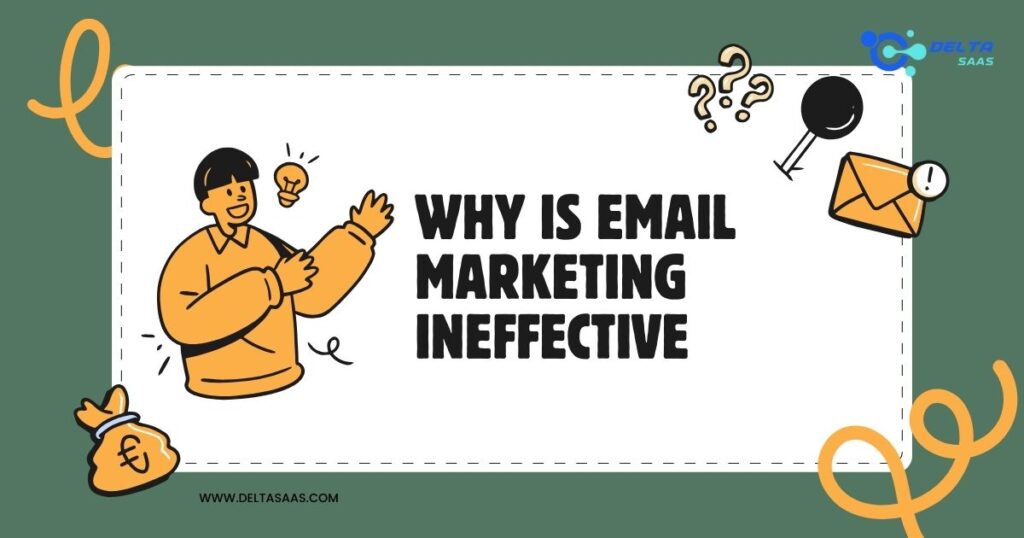Why Is Email Marketing Ineffective? Causes and Solutions
Email marketing has long been a cornerstone of digital marketing. Yet, many businesses find their campaigns fail to deliver the expected results. This raises the question: why is email marketing ineffective for some? To understand, let’s explore the key issues behind underperforming email campaigns and how to fix them.
Misaligned Email Campaign Objectives
The primary reason email marketing falls short is unclear or misaligned objectives. Businesses often need to define measurable goals to run campaigns. Without a clear purpose, emails lack focus and fail to engage.
Common Campaign Objectives That Fail:
- Sending bulk emails without audience segmentation.
- Prioritizing quantity over quality in subscriber lists.
- Focusing solely on sales, ignoring value or relationship-building.
Instead, campaigns should set realistic objectives such as improving open rates, driving conversions, or nurturing leads. Each campaign should have a purpose that aligns with overall marketing strategies.
Poor Audience Segmentation
Email marketing becomes ineffective when businesses treat all customers the same. Sending identical emails to diverse audience groups can result in:
- Low open rates.
- Poor click-through rates.
- Decreased customer engagement.
Why Audience Segmentation Matters:
- Not all customers are at the same stage of the buying process.
- Different segments respond to tailored messages.
- Generic content needs to address specific pain points.
Businesses can segment audiences by location, purchase history, or engagement level using tools like marketing automation. Personalized emails improve customer experiences and increase conversion rates.
Read More Best Reviews:
Maximizing Business Success with ActiveCampaign Benefits
ActiveCampaign Pricing Plans: Find the Best Fit
AWeber Benefits: Key Features for Success
AWeber Pricing: Plans for Every Business
Blastable Lifetime Deal: AI-Powered Email Marketing Solution
BrandNav Lifetime Deal: Unlock Smarter Brand Insights
Constant Contact Features: Complete Guide for Business Success
Overlooking Personalization
Another reason email campaigns perform poorly is a lack of personalization. Generic greetings like “Dear Customer” or irrelevant offers frustrate recipients. Modern consumers expect tailored content that feels relevant to their needs.
How to Personalize Effectively:
- Use customer names and past purchase data.
- Recommend products based on browsing history.
- Send birthday discounts or location-specific offers.
Personalization improves engagement and ROI, but it must go beyond basic name-dropping and require thoughtful use of customer data.
Weak Email Copywriting
Poorly written emails are a common marketing failure. Recipients won’t bother reading if your copy doesn’t grab attention within seconds.
Signs of Ineffective Email Copywriting:
- Bland subject lines that fail to spark curiosity.
- Long-winded or confusing content.
- There is a need for clear CTAs (Call-to-Action).
Compelling subject lines and concise content are critical. Each email should guide readers toward a specific action, whether visiting your website, downloading a lead magnet, or completing a purchase.
Ignoring Mobile Responsiveness
Many businesses still need to send emails that look better on mobile devices. With over half of emails opened on mobile, ignoring responsiveness can destroy engagement.
Common Mobile Design Mistakes:
- Long paragraphs of text that are hard to read.
- Buttons or links are too small to click.
- Non-responsive templates that break on mobile screens.
Responsive design ensures your emails look professional and are easy to navigate, regardless of the device.
Failing to Address Email Deliverability
Even the best-designed email campaigns fail if they don’t reach inboxes. Spam filters, inactive email addresses, and poor sender reputations reduce deliverability.
How to Improve Deliverability:
- Avoid spammy words like “free” or “guaranteed” in subject lines.
- Regularly clean your subscriber list to remove inactive users.
- Authenticate your email domain using SPF, DKIM, and DMARC protocols.
High deliverability ensures emails reach the right audience and have the opportunity to perform well.
Overreliance on Email Marketing Alone
Some businesses view email marketing as a standalone solution rather than part of a broader marketing plan. This narrow approach limits its effectiveness.
How to Integrate Email with Other Channels:
- Use social media to grow your email list.
- Run retargeting ads for users who don’t engage with emails.
- Combine email with SMS or direct mail for better campaign reach.
Email marketing works best as one part of a cohesive digital marketing strategy.
Inconsistent Frequency
Sending emails too often can overwhelm subscribers, while infrequent emails can cause audiences to forget your brand. Striking the right balance is crucial.
Best Practices for Email Frequency:
- Monitor subscriber preferences to determine optimal timing.
- Send weekly newsletters or bi-weekly promotions for consistent engagement.
- Avoid overloading inboxes with daily emails unless requested.
Consistency builds trust, while irregular schedules confuse or annoy recipients.
Why Many Email Campaigns Fail to Convert
Even with good intentions, many email campaigns still need to achieve their goals. Let’s explore additional challenges and actionable solutions that make email marketing ineffective.
Lack of a Strong Lead Magnet
Lead magnets play a critical role in email marketing. They help businesses attract quality leads. A weak or non-existent lead magnet reduces sign-ups, lowering the conversion potential.
Common Lead Magnet Mistakes:
- Offering generic or low-value content.
- Failing to address customer pain points.
- Not aligning the lead magnet with the email campaign’s objectives.
Compelling Lead Magnet Examples:
- E-books or whitepapers tailored to your audience’s interests.
- Free trials or exclusive discounts for new subscribers.
- Checklists, templates, or tools that solve specific problems.
Investing in a high-quality lead magnet increases your chances of capturing interested, high-intent subscribers.
Read More: How to Increase Click-Through Rate in Email Marketing: A Complete Guide
Spam Filters and Email Vulnerability
Spam filters are a significant part of email campaigns. Even well-intentioned emails can get flagged as spam, making them invisible to your audience.
Reasons Emails Get Marked as Spam:
- Poor subject line practices, like using excessive punctuation or caps.
- Sending to outdated or purchased email lists.
- Including too many images or irrelevant links.
How to Avoid Spam Filters:
- Use double opt-in processes to verify subscriber interest.
- Write clear, transparent, honest subject lines. Avoid misleading language.
- Maintain a clean and engaged subscriber list.
Additionally, monitor metrics like bounce rates, unsubscribe rates, and spam complaints to identify problems early.
Neglecting Metrics and Campaign Optimization
Ineffective email marketing often results from ignoring performance metrics. Businesses that fail to measure and optimize their campaigns miss opportunities to improve ROI.
Key Email Marketing Metrics to Track:
| Metric | Purpose |
| Open Rates | Measures subject line and sender reputation. |
| Click-Through Rates | Indicates email content relevance. |
| Conversion Rates | Tracks the number of actions taken. |
| Bounce Rates | Reflects email deliverability issues. |
| Unsubscribe Rates | Highlights audience dissatisfaction. |
Campaign optimization requires analyzing these metrics to understand what’s working and what isn’t. For instance, low open rates could signal poor subject lines, while high bounce rates might indicate deliverability issues.
Failing to Write a Clear CTA
Every email needs a purpose, but many campaigns fail because of unclear or missing CTAs. While recipients may read your email, your efforts are wasted if there is no next step.
Examples of Weak CTAs:
- Vague phrases like “Click here” without context.
- CTAs are buried within long paragraphs of text.
- There are too many competing CTAs in a single email.
How to Write an Effective CTA:
- Make CTAs action-oriented (e.g., “Get Your Free Quote”).
- Use contrasting colors to make buttons stand out.
- Limit each email to one or two CTAs to avoid confusion.
A strong CTA is the bridge between your email content and conversions.
Read More: Automated Email Marketing: Boost Campaign Success
Focusing Too Much on Sales
Email marketing campaigns that push aggressive sales tactics often backfire. While driving sales is essential, overly promotional emails can alienate your audience.
Why Hard-Sell Emails Fail:
- They come across as pushy or spammy.
- They ignore the need to build trust and rapport.
- They need to provide value or solve problems for recipients.
Alternative Approaches to Build Relationships:
- Please share with us helpful how-to guides or case studies.
- Send personalized product recommendations based on past purchases.
- Use newsletters to keep your audience informed about trends or updates.
Emails that balance value and promotion foster long-term trust and increase engagement.
Ignoring Email Marketing Best Practices
Many email marketing failures stem from poor adherence to proven best practices. Following established guidelines ensures your campaigns are practical and professional.
Best Practices for Email Marketing Success:
- Always get consent before sending emails (opt-in).
- Use an eye-catching subject line to boost open rates.
- Keep emails concise and to the point.
- Test emails across devices and browsers for compatibility.
- A/B test subject lines, email designs, and CTAs for performance.
Following these practices can avoid common pitfalls and improve your campaign’s success.
Insufficient Testing and Feedback
One overlooked factor in failed campaigns is the need for more testing. Many businesses must review their performance or seek customer feedback before emailing.
Testing and Optimization Strategies:
- A/B Testing: Experiment with different subject lines, layouts, or CTAs.
- Split Testing: Compare the performance of two distinct email variations.
- Feedback Surveys: Ask subscribers for their preferences or opinions.
Continual testing and refinement ensure your campaigns remain relevant and effective over time.
Read More: Choosing Effective Newsletter Services for Your Business
Overcoming Ineffective Email Marketing with Long-Term Strategies
The third part of understanding why email marketing fails lies in strategic, long-term planning. With a sustainable approach, even well-optimized campaigns can gain momentum. Let’s explore the remaining reasons why email marketing can become ineffective and actionable steps to ensure success.
Ignoring Changes in Marketing Trends
Email marketing isn’t static. Marketing trends evolve, and failing to adapt can lead to outdated or irrelevant campaigns.
Examples of Outdated Practices:
- Relying solely on text-based emails without multimedia.
- Using non-personalized templates across all campaigns.
- Sending emails at random times without considering recipient behavior.
Key Trends Businesses Should Adopt:
- Interactive content like polls, quizzes, or GIFs.
- AI-driven personalization to predict customer preferences.
- Dynamic email templates that adjust content based on user data.
Keeping up with email marketing trends ensures campaigns stay fresh and relevant, improving engagement rates and ROI.
Weak or Inconsistent Branding
Your email campaigns are an extension of your business. Weak branding or inconsistent design can confuse recipients and damage trust.
Signs of Poor Branding in Emails:
- Different colors, fonts, or tones of voice across campaigns.
- Emails that don’t align with your website or social media branding.
- There is a lack of a recognizable sender name or logo.
How to Strengthen Email Branding:
- Use the same color scheme, logo, and fonts in all emails.
- Write in a tone consistent with your other marketing channels.
- Include a professional email signature and precise sender details.
Consistency in branding builds credibility and helps customers recognize your emails instantly.
Read More: Email Marketing for Lead Generation: A Complete Guide
Overlooking Email Timing
Sending emails at the wrong time can lead to low open rates, even for well-written campaigns. Timing plays a critical role in whether recipients engage with your content.
Best Practices for Email Timing:
- Analyze when your audience is most active (e.g., mornings vs. evenings).
- Avoid sending during weekends or holidays unless relevant.
- Use marketing automation tools to schedule emails for optimal delivery times.
Timing emails correctly boosts the chances of them being seen and acted upon.
The Role of Poor Email Templates
Using poorly designed or outdated email templates can ruin your campaign’s effectiveness. A cluttered or unattractive email layout discourages recipients from engaging.
Template Mistakes That Hurt Performance:
- Overcrowded designs with too much text or imagery.
- Templates that aren’t mobile-friendly.
- Confusing layouts with no clear flow or hierarchy.
How to Improve Email Templates:
- Keep designs simple, clean, and visually appealing.
- Highlight important information at the top of the email.
- Use tools like Mailchimp or HubSpot for professional, customizable templates.
An appealing template enhances readability and guides readers to your CTA.
Unrealistic Expectations and Misaligned ROI
Email marketing often fails when businesses set unrealistic goals. While it’s a powerful tool, it doesn’t guarantee instant results. Misaligned expectations can lead to disappointment and wasted resources.
Reasons for Unrealistic Expectations:
- Assuming email will replace other channels entirely.
- Expecting instant sales from every campaign.
- Refrain from measuring long-term benefits, like customer retention.
How to Align ROI Goals:
- Define what success looks like (e.g., 10% higher open rates or 5% improved conversions).
- Use email as a broader marketing strategy, not the sole focus.
- Measure long-term metrics like lifetime customer value (LCV) alongside immediate results.
Understanding email’s role in the marketing strategy helps businesses see its actual value.
Read More: Email Marketing for SMBs: Easy Strategies
Failing to Address Subscriber Needs
Businesses may need to pay more attention to what their audience wants when focusing too much on their goals. Ignoring subscriber preferences leads to disengagement and higher unsubscribe rates.
Signs You’re Missing the Mark:
- High unsubscribe rates after campaigns.
- Emails that consistently receive low engagement.
- Lack of feedback or responses from recipients.
Solutions to Align with Subscriber Needs:
- Conduct audience surveys to understand preferences.
- Offer subscription options, such as frequency or content type.
- Use marketing statistics to identify trends and adjust content.
By placing subscribers at the center of your campaigns, you can foster stronger relationships and boost loyalty.
The Importance of Measuring Results
Email marketing becomes effective when businesses correctly measure results. Without tracking performance, it’s impossible to identify weaknesses or opportunities for growth.
Metrics Every Campaign Should Measure:
- Open Rates: Gauge how well your subject lines perform.
- Click-Through Rates: Assess content relevance and CTA effectiveness.
- Bounce Rates: Identify deliverability issues.
- Conversion Rates: Measure how many recipients took action.
Regularly analyzing these metrics allows businesses to optimize future campaigns and improve overall results.
Practical Examples of Ineffective Email Campaigns
Real-life examples can highlight what to avoid in email marketing. Below are common mistakes businesses make, along with lessons learned:
| Example | Why It Failed | Takeaway |
| Sending identical emails to all | Lacked segmentation is irrelevant for many readers. | Segment audiences for better targeting. |
| Overloading emails with links | Confused readers and weakened the CTA focus. | Use one clear CTA per email. |
| Using a misleading subject line | Lost audience trust after opening the email. | Be honest in subject lines. |
| Ignoring mobile compatibility | Poor display on phones led to unsubscribes. | Always use mobile-friendly templates. |
Learning from these examples ensures your campaigns don’t repeat similar mistakes.
Conclusion
Email marketing can become ineffective for various reasons, from poor audience segmentation to ignoring metrics and best practices. Businesses often need help with personalization, deliverability, and aligning their campaigns with subscriber needs. However, email campaigns can deliver meaningful results by addressing these issues and adapting to evolving marketing trends.
Key takeaways include:
- Prioritize clear objectives, strong CTAs, and audience segmentation.
- Focus on personalization, responsiveness, and compelling templates.
- Regularly measure and optimize metrics for long-term success.
When done right, email marketing remains one of the most effective tools in digital marketing, offering unmatched ROI and audience reach.
FAQs
Why do email campaigns fail to convert?
They fail due to poor targeting, weak CTAs, or lack of value.
What are common email marketing mistakes?
Generic emails, poor segmentation, and ignoring mobile users are common mistakes.
How can I improve my email open rates?
Write compelling subject lines and personalize content.
What metrics should I track for email campaigns?
Track open rates, click-through rates, bounce rates, and conversions.
Is email marketing still effective in 2025?
Yes, when combined with modern personalization and segmentation strategies.
How do spam filters affect email campaigns?
Spam filters block emails with spammy language or poor sender reputations.
What’s the role of a lead magnet in email marketing?
Lead magnets attract high-quality subscribers by offering value upfront.
Why is personalization important in email marketing?
It makes emails relevant, boosting engagement and conversions.
How often should I send emails to subscribers?
Send emails consistently based on audience preferences and engagement rates.
What is a good CTA for email campaigns?
Clear, action-oriented CTAs like “Sign Up Now” or “Learn More” perform well.


